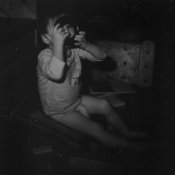If you look hard, you can find the equivalent of 87 and 89 filters in large sheets. 87 filters used to be available in 5-1/4 inch round safelight filter form, and there may still be some hiding somewhere. These filters can be used over a light source to make photographs in the dark (or nearly dark for the 89). I also came across this formula for coating flashbulbs. It is more or less an 89 filter. It could be coated on glass or plastic to be placed over a light source.
Recipe for Coating Flash Bulbs with Infrared Paint
From a 1970 photo-lab-index, "Blackout Coating for flashbulbs".
Eosin 2524 60 grains 4.0 grams
Tartrazine N. 250 88 grains 6.0 grams
Coomassie Violet RS 60 grains 4.0 grams
Lissamine Green 146 grains 10.0 grams
Gelatin (hard) 6+3/4 ounces 200.0 grams
Glycerin 3+1/4 fl. Oz 100.0 cc
Add cold water to make 32 ounces 1.0 litre
"The gelatin is first soaked in half the quantity of water for one hour, then warmed to 120 degrees F (49C) and stirred until dispersed. The dyes are dissolved separately in small quantities of water at not above 150 degrees F (65C). Each dye is mixed with a small quantity of the gelatin solution to prevent precipitation when they are later mixed. The glycerin is diluted with another small portion of water, then all ingredients are mixed and brought to the final volume with water at 120 degrees F (49C).
"If necessary the mixture is filtered through two layers of muslin to remove air bubbles, then cooled to 96 degrees F (36C). At this temperature the flashbulbs are dipped in the mixture until completely covered. On removal from the solution they are drained for a few seconds, then inverted and the remaining solution is permitted to spread back over the surface rather than draining. They should appear almost black and it should be impossible to see within the bulb. Drying takes about 24 hours. These bulbs may then be used with any regular infrared film for photography in complete darkness.
"The formula above is a British formula and the dye materials mentioned are of British manufacture... American dyes are...
Then it lists different companies with some equivalent products. I'm a couple blocks from Aldrich Chemical Co. and they carried all the materials. Based on quantities that were available it would cost about $100. I wonder if there is somewhere to buy the dyes at lesser purities. Anyway here are some equivalent dyes that are listed then in the book: Tartrazine N. 250 = Tartrazine Conc. or Wool Yellow X Conc.; Coomassie Violet RS = Pontacyl Violet 4BL, Conc. 125 percent or Formyl Violet S4B or Wool Violet 4BN; and Lissamine Green = Pontacyl Green SN Extra or Wool Green S. All the "wool" colors were supplied by National Aniline Corp in NY. I kept the capitalization and abbreviation the same as the text pretty much, so thats all the clues you get. Are there any chemists in the crowd?
Well, glycerin and gelatin are common, cheap and safe enough. I wouldn't think that dyes would be that expensive, but the ones from chemical supply houses are very pure and somewhat expensive. Maybe a mixture of common clothing dyes would work... or maybe one part lime jello, one part grape jello and...
If you try out this recipe please let me know how you get on.
Ref: Last Updated: Tuesday, September 28, 1999
(
http://www.cocam.co.uk/CoCamWS/Infrared/IRpaint.htm)









